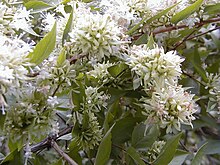Abelia
 From Wikipedia the free encyclopedia
From Wikipedia the free encyclopedia
| Abelia | |
|---|---|
 | |
| Abelia chinensis | |
| Scientific classification | |
| Kingdom: | Plantae |
| Clade: | Tracheophytes |
| Clade: | Angiosperms |
| Clade: | Eudicots |
| Clade: | Asterids |
| Order: | Dipsacales |
| Family: | Caprifoliaceae |
| Subfamily: | Linnaeoideae |
| Genus: | Abelia R.Br. (1818) |
| Species[1] | |
| |
Abelia /əˈbiːliə/[2] is a genus of flowering plants in the honeysuckle family, Caprifoliaceae. The genus currently includes six species native to China, Taiwan, and Vietnam.[1]
The genus previously contained about 30 species and hybrids. Molecular phylogenetic studies showed that the genus was not monophyletic. In 2013, Maarten Christenhusz proposed the merger of Abelia (excluding section Zabelia) into Linnaea, along with some other genera, and the majority of Abelia species were transferred to Linnaea. Abelia section Zabelia was raised to the genus Zabelia.[3][1]
Description[edit]
Species of Abelia are shrubs from 1–6 m tall. Species from warm climates are evergreen, and colder climate species deciduous. The leaves are opposite or in whorls of three, ovate, glossy, dark green, 1.5–8 cm long, turning purplish-bronze to red in autumn in the deciduous species. The flowers appear in the upper leaf axils and stem ends, 1-8 together in a short cyme; they are pendulous, white to pink, bell-shaped with a five-lobed corolla, 1–5 cm long, and usually scented. Flowering continues over a long and continuous period from late spring to fall.
Some of these species are cultivated as ornamental garden plants, and may still be described as Abelia in horticultural listings. A notable example is the hybrid Abelia × grandiflora.
Taxonomy[edit]
The generic name commemorates Clarke Abel, a keen naturalist who accompanied Lord Amherst's unsuccessful embassy to China in 1816 as a surgeon, under the sponsorship of Sir Joseph Banks. All of Abel's seeds and plants were lost in a shipwreck on the homeward voyage, however; living plants of Abelia chinensis (now Linnaea chinensis) were first imported to England in 1844 by Robert Fortune.[4]
Some species placed in Abelia were transferred to Linnaea at various times from 1872 onwards, but these transfers were not accepted by most botanists. Molecular phylogenetic studies showed that a number of genera traditionally placed in the tribe Linnaeeae were closely related, but that Abelia was not monophyletic, even with Abelia section Zabelia split off as a separate genus Zabelia. In 2013, Maarten Christenhusz proposed that Abelia and related genera be merged into Linnaea.[3] Plants of the World Online currently accepts the transfer of the majority of species to Linnaea, with six Asian species remaining in the genus.[1][5]
Allergenicity[edit]
Abelia has an OPALS allergy scale rating of 5 out of 10, indicating moderate potential to cause allergic reactions, exacerbated by over-use of the same plant throughout a garden.[6] People allergic to honeysuckle may experience cross-reactive allergic reactions with Abelia.[6]
Symbolism[edit]
The Abelia is symbolic for equality in some parts of Mexico.
Species[edit]
Six species are accepted.[1]
- Abelia chinensis R.Br.
- Abelia forrestii (Diels) W.W.Sm.
- Abelia × grandiflora (Rovelli ex André) Rehder (artificial hybrid of A. chinensis × A. uniflora)
- Abelia macrotera (Graebn. & Buchw.) Rehder
- Abelia parvifolia Hemsl.
- Abelia schumannii (Graebn.) Rehder
- Abelia uniflora R.Br.
Former species and synonyms[edit]
Species and synonyms previously placed in Abelia but now placed in other genera include:[7]
- Abelia adenotricha = Lonicera elisae
- Abelia aitchinsonii = unplaced
- Abelia angustifolia = Zabelia angustifolia
- Abelia anhweiensis = Zabelia dielsii
- Abelia biflora = Zabelia biflora
- Abelia brachystemon = Zabelia brachystemon
- Abelia buchwaldii = Linnaea serrata
- Abelia buddleioides = Zabelia buddleioides
- Abelia coreana = Zabelia dielsii
- Abelia coriacea = Linnaea coriacea
- Abelia corymbosa = Zabelia corymbosa
- Abelia curviflora = Linnaea spathulata
- Abelia davidii = Zabelia biflora
- Abelia deutziifolia = Linnaea engleriana
- Abelia dielsii = Zabelia dielsii
- Abelia engleriana = Linnaea engleriana
- Abelia floribunda = Linnaea floribunda
- Abelia graebneriana = Linnaea engleriana
- Abelia grandifolia = Linnaea grandifolia
- Abelia gymnocarpa = Linnaea serrata
- Abelia hersii = Zabelia dielsii
- Abelia hirsuta = Linnaea floribunda
- Abelia insularis = Zabelia biflora
- Abelia integrifolia = Zabelia integrifolia
- Abelia ionostachya = Linnaea spathulata
- Abelia koehneana = Linnaea engleriana
- Abelia mexicana = Linnaea mexicana
- Abelia mosanensis = Zabelia tyaihyonii
- Abelia occidentalis = Linnaea occidentalis
- Abelia onkocarpa = Zabelia onkocarpa
- Abelia sanguinea = Linnaea spathulata
- Abelia serrata = Linnaea serrata
- Abelia shikokiana = Zabelia biflora
- Abelia spathulata = Linnaea spathulata
- Abelia speciosa = Linnaea floribunda
- Abelia splendens = Lonicera fragrantissima
- Abelia tetrasepala = Linnaea tetrasepala
- Abelia tomentosa = Linnaea serrata
- Abelia tyaihyonii = Zabelia tyaihyonii
- Abelia umbellata = Zabelia umbellata
- Abelia zanderi = Zabelia dielsii
References and external links[edit]
- ^ a b c d e Abelia R.Br. Plants of the World Online. Retrieved 25 April 2024.
- ^ Sunset Western Garden Book. 1995. pp. 606–607.
- ^ a b Christenhusz, Maarten J.M. (2013), "Twins are not alone: a recircumscription of Linnaea (Caprifoliaceae)", Phytotaxa, 125 (1): 25–32, CiteSeerX 10.1.1.397.846, doi:10.11646/phytotaxa.125.1.4, S2CID 86036432
- ^ Alice M. Coats, Garden Shrubs and Their Histories (1964), 1992, s.v. "Abelia".
- ^ "Beauty bush (Linnaea amabilis)". iNaturalist. California Academy of Sciences. Retrieved 2018-01-22.
- ^ a b Ogren, Thomas Leo (2000). Allergy-Free Gardening. Berkeley, California: Ten Speed Press. ISBN 1580081665.
- ^ "Abelia", Plants of the World Online, Royal Botanic Gardens, Kew, retrieved 2018-01-23